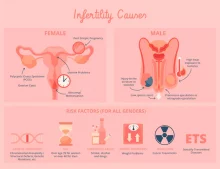
Ovarian cysts and sciatica are two similar yet different conditions. Ovarian cysts are fluid-filled sacs in the ovary that develop during early pregnancy. They can occur in both women and men. In men, they are called varicocele or hydrocele, which is a buildup of fluid in an area outside the testicle (the scrotum). Sciatica is a type of back pain that originates in the sciatic nerve, and it’s usually caused by tightness or irritation of the muscles around the spine. The two conditions often present with similar symptoms, but they also have differences that you should be aware of if you think you might have either one. Read on to learn more about these issues.
What is a Sciatica?
Sciatica is back pain caused by compression of the sciatic nerve. This nerve runs from the spinal cord down the back and into the buttock muscles. The sciatic nerve is the longest nerve in the human body, and it gives sensory information in the buttocks and legs. In a sciatica, an irritation or inflammation of the tissues surrounding the sciatic nerve may cause pain and weakness in these muscles. If you have sciatica, it may feel like a dull ache in your lower back, buttocks, or legs. You may also have weakness in these muscles or a loss of sensation in these areas. Sciatica can occur at any time, but it’s most common during the winter months. It’s important to note that sciatica is often confused with other conditions. One of these conditions is ovarian cysts.
What Is an Ovarian Cyst?
An ovarian cyst is a fluid-filled sac that forms in the ovary. Cysts can occur at any age, but they’re most common in women between the ages of 20 and 55. Cysts are most often benign and painless. They occur when the ovary doesn’t release an egg quickly enough during ovulation. However, ovarian cysts can occasionally be caused by abnormal growth of the ovary. Some of these types of cysts are called dysgerminomas, which are cancerous and need to be removed. If you experience pain or irregularities with your periods, you may have an ovarian cyst. Cysts can also occur as part of the menstrual cycle. Often, a person with an ovarian cyst will experience irregular or heavier periods as part of the cycle. If you have an ovarian cyst that occurs regularly during your cycle, you may experience cramps, back pain, or bloating.
Sciatica and Ovarian Cyst: Similarities and Differences
Both sciatica and ovarian cysts are imbedded and non-cancerous conditions of the ovary. In both cases, the ovary develops cysts that cause pain and weakness in the posterior pelvic muscles. However, ovarian cysts are benign, while sciatica is a serious condition. Sciatica is a condition that affects the lower back and buttock muscles. It can occur at any time, but it’s most common during the winter. The sciatic nerve runs down the back and into the legs as well as the buttocks. When the buttock muscles are irritated or compressed by a herniated bone or other cause, the sciatic nerve can be affected. Cysts can occur at any age, but the most common age group is between the ages of 20 and 55. Both conditions are painful and need treatment. However, ovarian cysts are benign, while sciatica is a serious condition.
How to Treat Sciatica
The first step in treating sciatica is to rule out any other causes for the pain. This may require an investigation to determine if there is a need for further testing. If the pain is likely due to compression of the sciatic nerve, you may need a scan to determine the extent of the problem. Once the source of your pain is identified, you can treat the condition with gentle stretches, exercise, or both. You can do these while lying on your side or even while in the bath. Stretching is important because it helps to improve the flexibility of your back muscles and improve blood flow to the affected area. Another important aspect of treating sciatica is pain management. Before you begin any type of exercise regimen, it’s important to take an opioid painkiller or nerve-relieving medication such as ibuprofen.
How to Treat Ovarian Cyst
The treatment for ovarian cysts depends on the type of cyst you have. Some cysts don’t require any treatment at all. Other types of cysts, however, may require medical intervention. When a cyst is benign, it may be possible to simply let it go on its own. However, if the cyst is large or painful, you may need treatment. Cysts that don’t require treatment may go away on their own in six to 12 months. If the cyst is large or painful, you can try to treat it yourself by taking ibuprofen or consuming apple cider vinegar. If home treatment isn’t working, you may want to visit your doctor. A doctor may perform an ultrasound or biopsy to determine the type of cyst and treatment options. Your doctor may recommend medication, surgery, or both.
Conclusion
If you have sciatica, you may find that simple stretching or exercise isn’t enough to relieve your pain. You may need to visit a physician to have a scan to determine the extent of the problem. For other types of cysts, you may only need to treat them yourself with over-the-counter medications or treatment options such as surgery or cryotherapy. If your cyst isn’t painful, it doesn’t require treatment, or it goes away on its own, you don’t need to visit your doctor.
